Study on Sealing Performance of Spring-Embedded Shoulder Protection Packer Rubber Cylinder
Abstract
1. Introduction
2. Structural Design of Spring-Embedded Shoulder Protection Packer Rubber Cylinder
3. Analysis of Sealing Performance of Spring-Embedded Shoulder Protection Packer Rubber Cylinder
3.1. Establishment of Finite Element Model for Rubber Cylinder
3.2. Finite Element Analysis of Rubber Cylinder
3.2.1. Analysis of Axial Compression Distance of Rubber Cylinder
- where —percentage of compression distance;
- —traditional packer cartridge compression distance, mm;
- —spring-embedded shoulder protection packer rubber cylinder compression distance, mm.
3.2.2. Mises Stress Analysis of Rubber Cylinder
- where —Mises stress reduction percentage;
- —the maximum Mises stress of conventional packer cartridge, MPa;
- —the maximum Mises stress of spring shoulder packer cartridge, MPa.
3.2.3. Analysis of Contact Stress between Spring-Embedded Shoulder Protection Packer Rubber Cylinder and Traditional Packer Rubber Cylinder on the Sleeve
3.2.4. Evaluation of Sealing Performance of Rubber Cylinder
- where —sealing performance factor K increases by percentage;
- —sealing performance coefficient of spring shoulder packer rubber casing;
- —sealing performance coefficient of traditional packer cartridge.
4. Conclusions
Author Contributions
Funding
Data Availability Statement
Conflicts of Interest
References
- Zheng, X.; Li, B. Study on sealing performance of packer rubber based on stress relaxation experiment. Eng. Fail. Anal. 2021, 12, 105692. [Google Scholar] [CrossRef]
- Tang, Y.; Sun, P.; Wang, G.; Li, W. Analysis of pressure-bearing performance and optimization of structural parameters of the slip in a compression packer. Sci. Prog. 2020, 103, 36850419881106. [Google Scholar] [CrossRef] [PubMed]
- Zuo, R.; Wang, G.; Hu, G.; Lei, Z.; Shen, K. Theoretical research on sealing performance of packing element used in the dual gradient packer considering stress relaxation effect. J. Braz. Soc. Mech. Sci. Eng. 2022, 44, 237. [Google Scholar] [CrossRef]
- Deng, T.; Zeng, Z.; Xu, J.; Wen, J. A geometric analysis-based approach toward mechanical analytics of multi-packer completion tubular string. J. Pet. Explor. Prod. Technol. 2024, 14, 1553–1588. [Google Scholar] [CrossRef]
- Abid, K.; Sharma, A.; Ahmed, S.; Srivastava, S.; Toledo Velazco, A.; Teodoriu, C. A Review on Geothermal Energy and HPHT Packers for Geothermal Applications. Energies 2022, 15, 7357. [Google Scholar] [CrossRef]
- Zhang, F.; Shui, C.H.; Zhang, Y. Parameter optimization of sealing performance for packer rubber. Ind. Lubr. Tribol. 2019, 71, 664–671. [Google Scholar] [CrossRef]
- Zhang, F.; Jiang, X.; Wang, H.; Song, N.; Chen, J.; Duan, J. Mechanical analysis of sealing performance for compression packer rubber tube. Mech. Ind. 2018, 19, 309. [Google Scholar] [CrossRef]
- Hu, G.; Zhang, P.; Wang, G.; Zhang, M.; Li, M. The influence of rubber material on sealing performance of packing element in compression packer. J. Nat. Gas Sci. Eng. 2017, 38, 120–138. [Google Scholar] [CrossRef]
- Liu, Z.; Li, S.; Zhang, L.; Wang, F.; Wang, P.; Han, L.; Ma, Y.; Zhang, H. Analysis of Sealing Mechanical Properties of Fracturing Packer Under Complex Conditions. J. Fail. Anal. Prev. 2019, 19, 1569–1582. [Google Scholar] [CrossRef]
- Pan, B.; Wu, W.; Li, D.; Luo, H. Research on the influence of new anti-outburst mechanism on the sealing performance of packer cartridge. Mech. Des. Manuf. 2020, 232–235. [Google Scholar]
- Cheng, Y.; Zhang, W.; Wang, K. Improvement of high-temperature and high-pressure test packers. Oil Gas Well Test. 2022, 31, 11–16. [Google Scholar]
- Wang, L.; Zhang, T.; Zhou, X. Correlation analysis of mechanical properties of dilated packer cylinder. Vibroengineering Procedia 2022, 43, 139–144. [Google Scholar] [CrossRef]
- Kopeikin, I.S. Development of a packer with an activation tool for the liner extension hanger in the interval of a horizontal open well. IOP Conf. Ser. Earth Environ. Sci. 2022, 981, 032071. [Google Scholar] [CrossRef]
- Zhang, D.; Wang, F.; Li, Q.; Han, X.; Feng, F.; Zhang, J. Study on early seal failure of CO2-injected packer based on orthogonal experimental method. Alex. Eng. J. 2023, 72, 695–707. [Google Scholar] [CrossRef]
- Liu, Y.; Lian, Z.; Chen, J.; Kuang, S.; Mou, Y.; Wang, Y. Design and Experimental Research on Sealing Structure for a Retrievable Packer. Shock Vib. 2020, 2020, 7695276. [Google Scholar] [CrossRef]
- Wang, P.; Cai, M.; Liu, Z.; Ma, W.; Li, J. Research on key technology of packer rubber barrel for integrated fracturing and completion of gas well. J. Pet. Explor. Prod. Technol. 2024, 14, 825–838. [Google Scholar] [CrossRef]
- Yue, Q.; Wang, X.; Liu, Y.; Cao, W.; Zhang, Q. Failure evaluations for packers in multistage fracturing technology with immobile strings. J. Pet. Sci. Eng. 2021, 206, 109039. [Google Scholar]
- Dong, L.; Liu, J. Failure analysis and optimization method research on sealing of deep shale gas ultra-high-pressure fracturing packer rubber. Proc. Inst. Mech. Eng. Part C J. Mech. Eng. Sci. 2022, 236, 10237–10259. [Google Scholar] [CrossRef]
- Jin, L.; Zhao, D.; Liu, J. A Visco-hyperelastic Constitutive Model for Rubber Considering the Strain Level and One Case Study in the Sealing Packer. Acta Mech. Solida Sin. 2023, 36, 710–723. [Google Scholar] [CrossRef]
- Kang, Y.; Long, Z.; Kang, T.; Ren, Z.; Shi, T.; Zhang, X. Adaptability of hydraulic fracturing packers and optimization of their sealing performance for three common clastic rock reservoirs based on finite element analysis. Front. Earth Sci. 2022, 10, 986344. [Google Scholar] [CrossRef]
- Der, O.; Alqahtani, A.A.; Marengo, M.; Bertola, V. Characterization of polypropylene pulsating heat stripes: Effects of orientation, heat transfer fluid, and loop geometry. Therm. Eng. 2020, 184, 116304. [Google Scholar] [CrossRef]
- Türköz, M.; Evcen, D. Investigation on the sealing performance of polymers at ultra high pressures. Int. Polym. Process. 2022, 37, 549–558. [Google Scholar] [CrossRef]
- Xu, S.; Manshaii, F.; Chen, G.; Chen, J. Reversible metal-ligand coordination for photocontrolled metallopolymer adhesives. Chem 2024, 10, 1638–1640. [Google Scholar] [CrossRef]
- Liu, Y.; Qian, L.; Zou, J.; Xia, C.; Lian, Z. Study on failure mechanism and sealing performance optimization of compression packer. Eng. Fail. Anal. 2022, 136, 106176. [Google Scholar] [CrossRef]
- Zhou, W.; Wang, C.; Fan, P.; Kuang, Y.; Dong, Z. The Sealing Effect Improvement Prediction of Flat Rubber Ring in Roller Bit Based on Yeoh Revised Model. Materials 2022, 15, 5529. [Google Scholar] [CrossRef]
- Lan, W.J.; Wang, H.X.; Zhang, X.; Chen, S.S. Sealing properties and structure optimization of packer rubber under high pressure and high temperature. Pet. Sci. 2019, 16, 632–644. [Google Scholar] [CrossRef]
- Hu, G.; Wang, M.; Wang, G.; He, X. Research on the Influence of Spacer Ring on the Sealing Performance of Packing Element used in Compression Packer. J. Fail. Anal. Prev. 2021, 21, 1605–1621. [Google Scholar] [CrossRef]


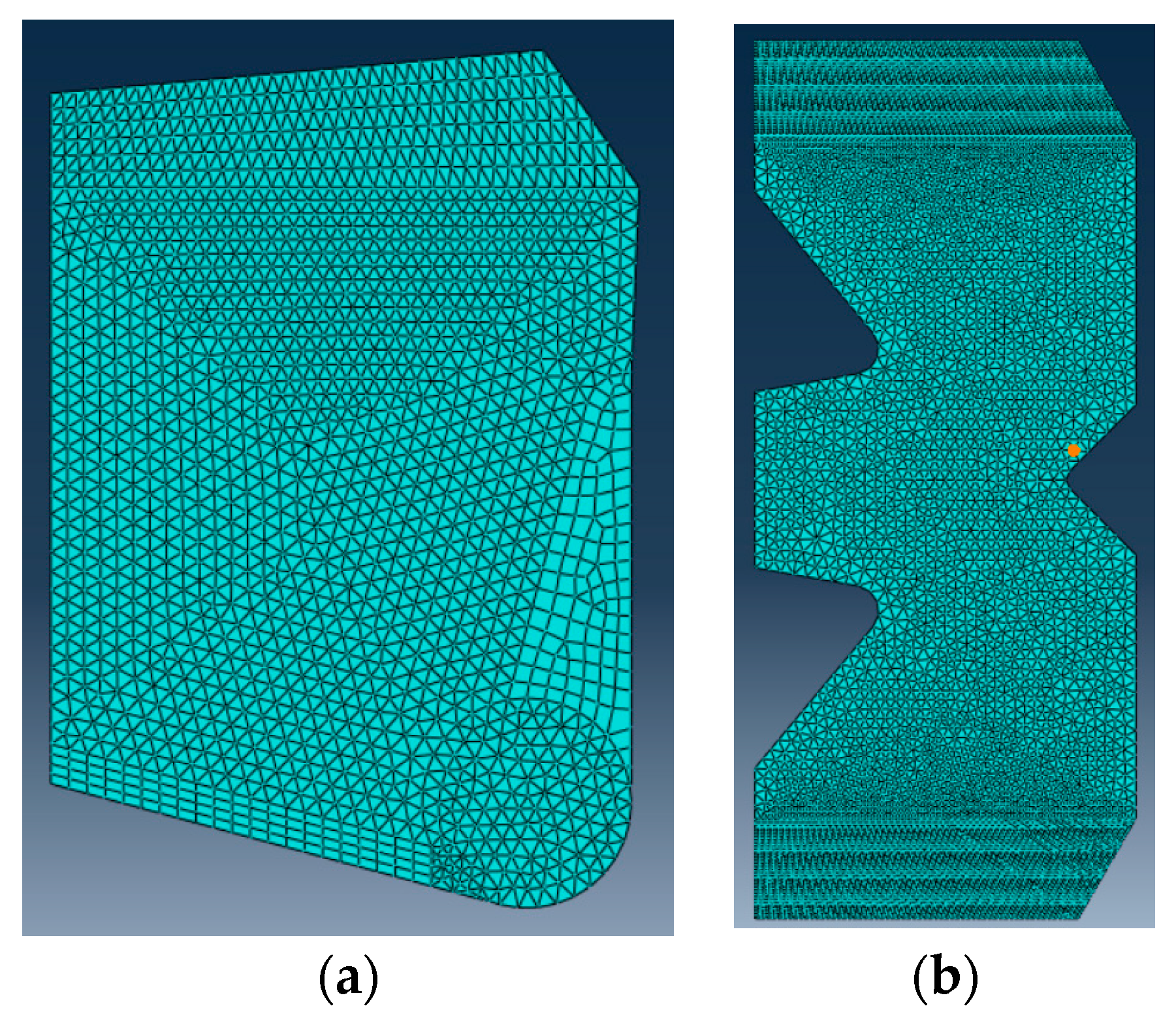
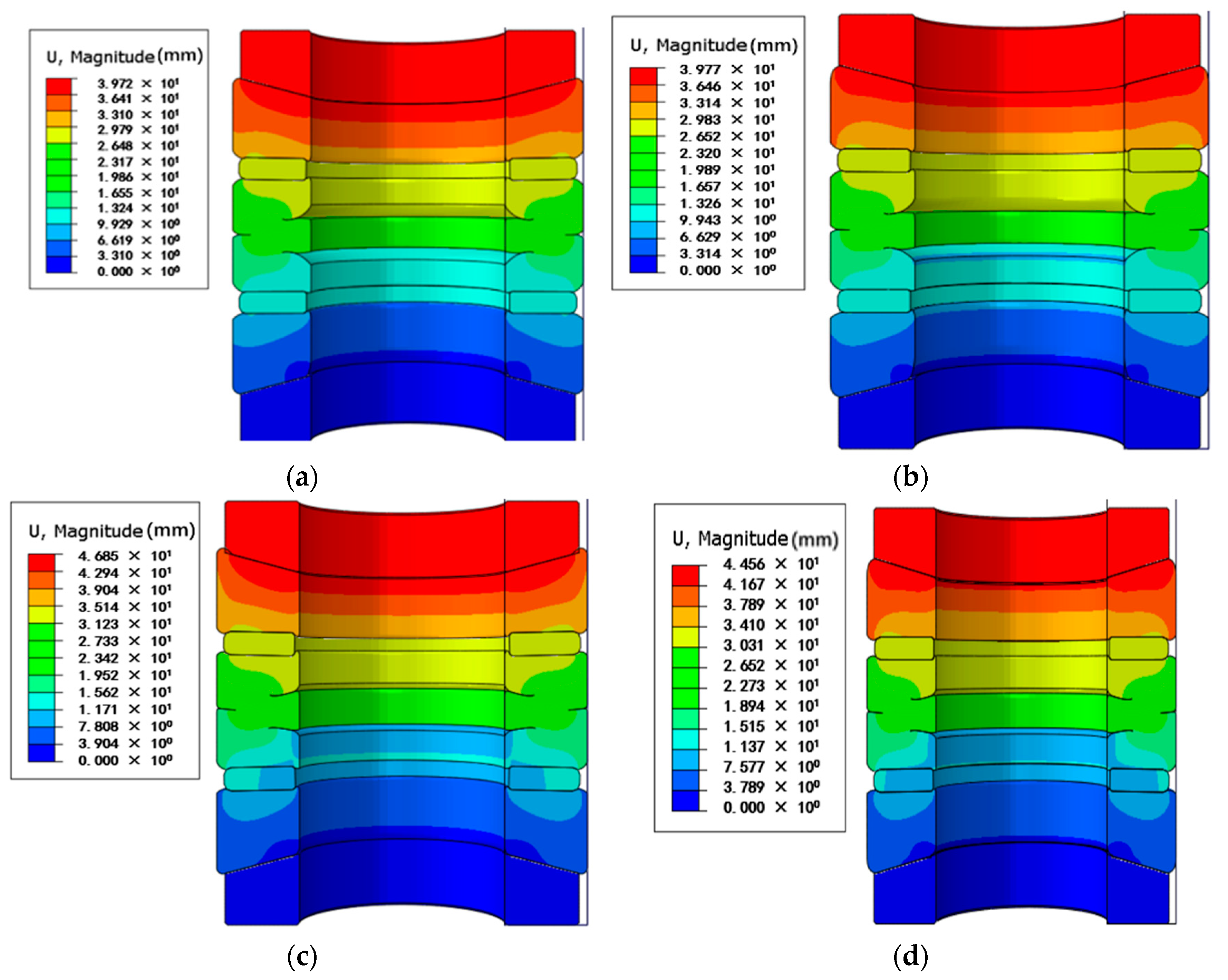
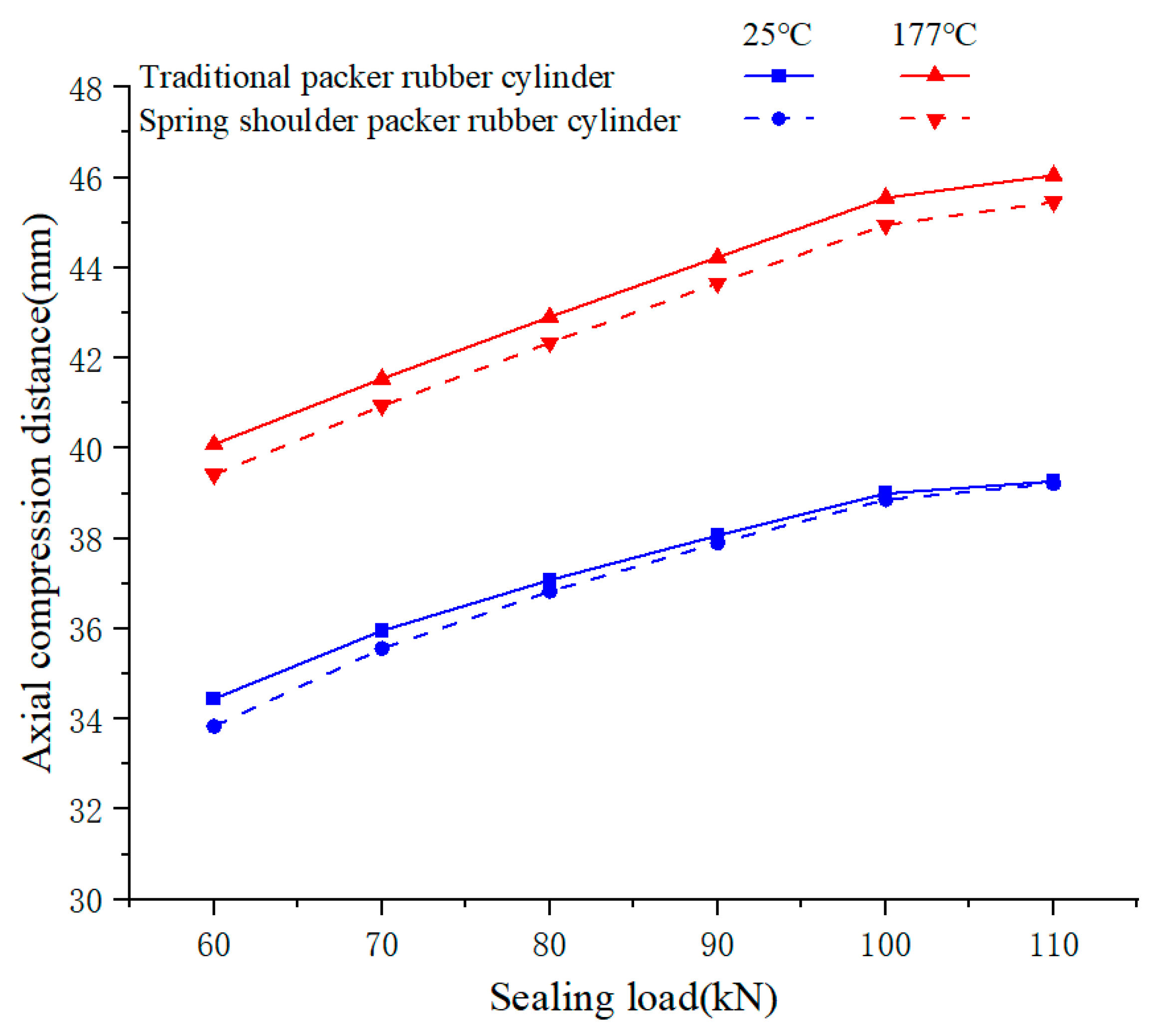
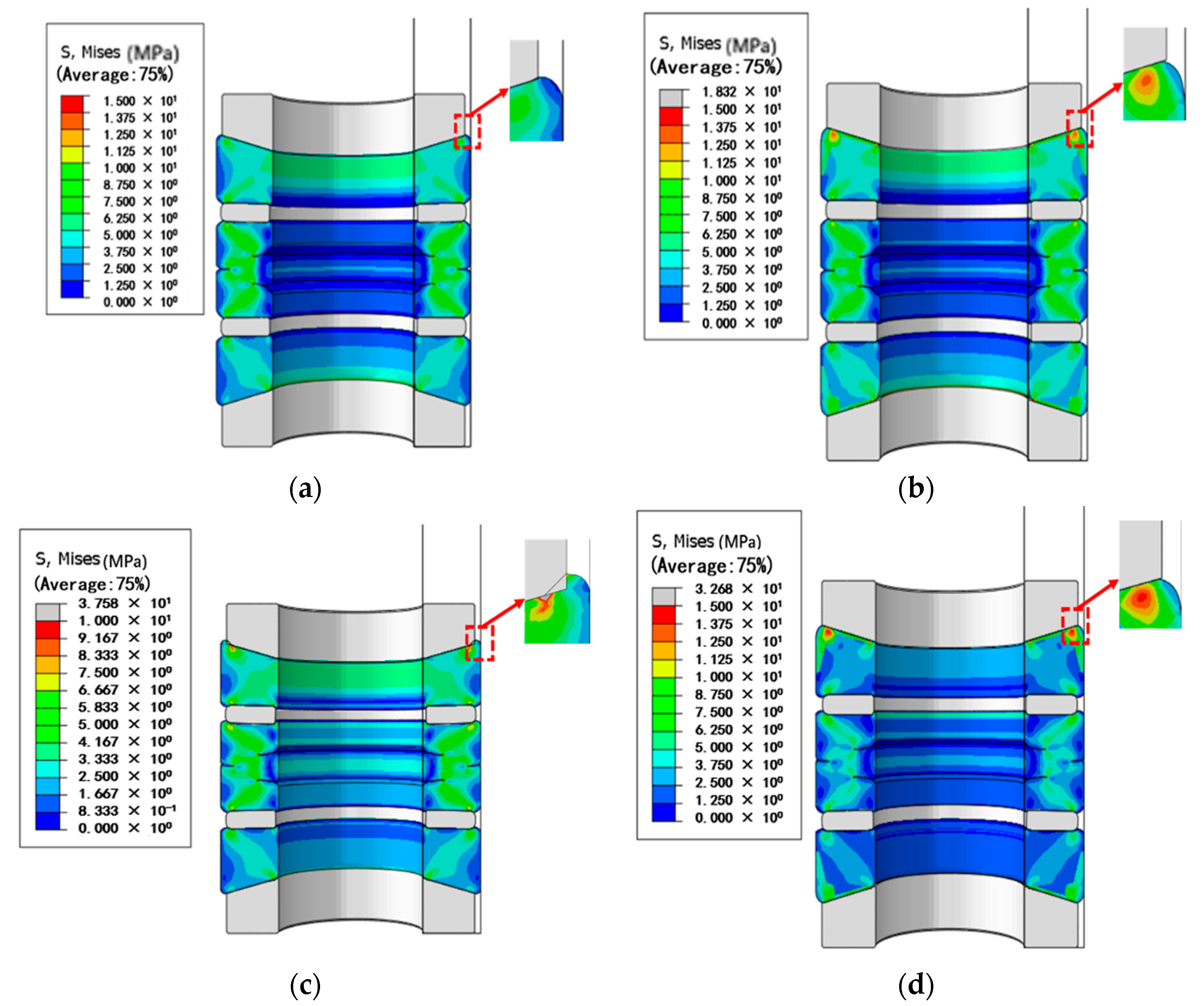
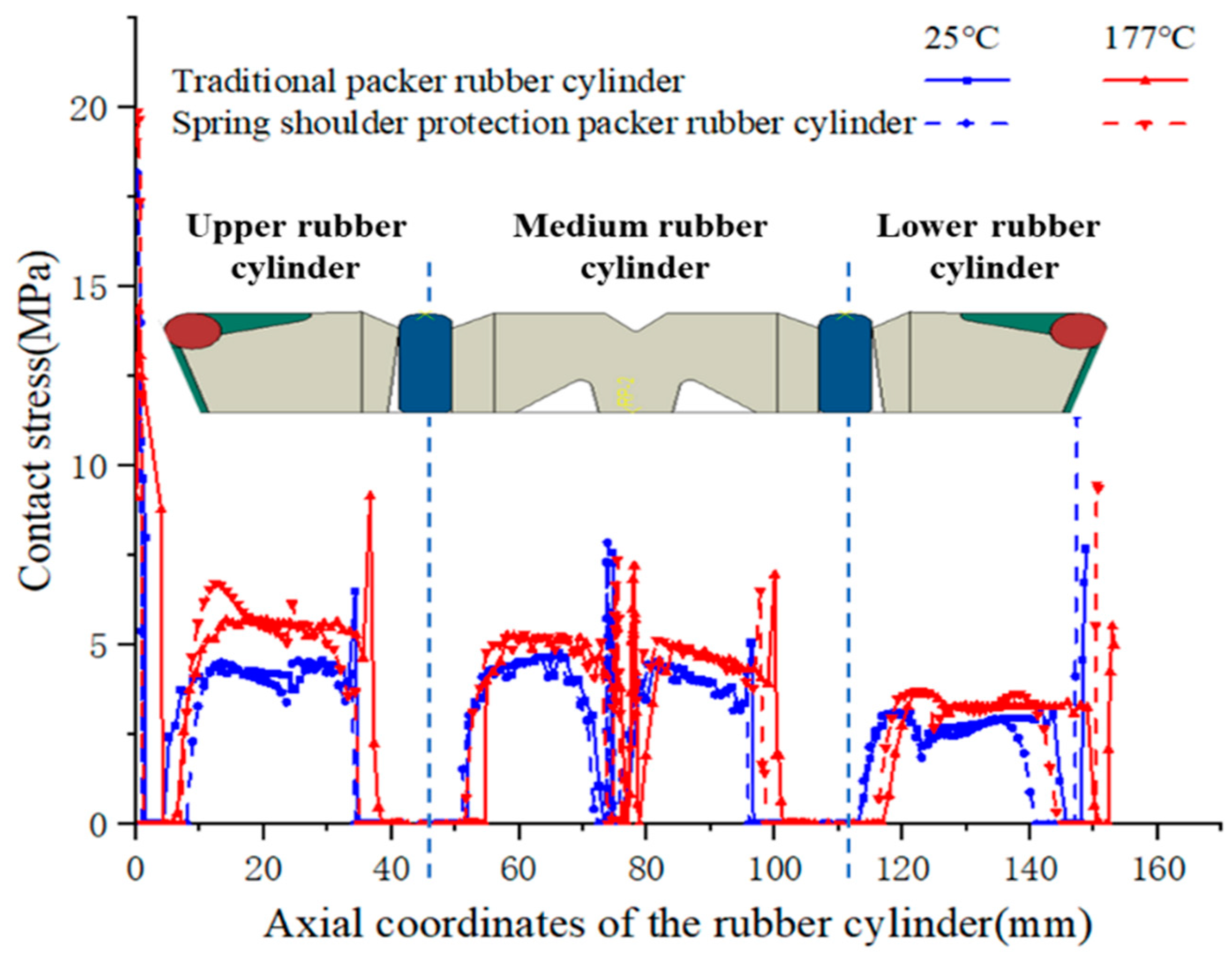
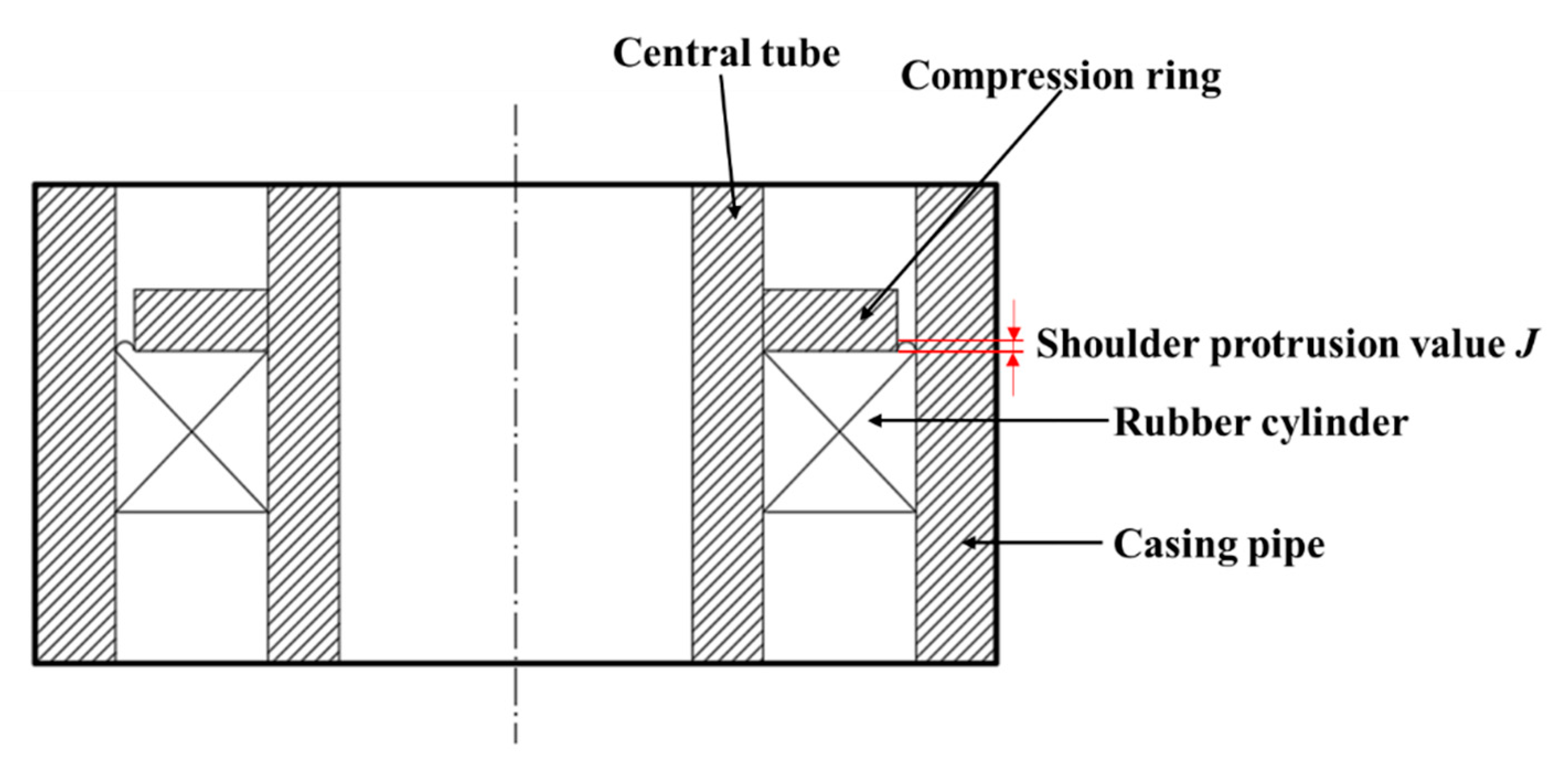
| Name | Internal Diameter/mm | External Diameter/mm | Height/mm |
|---|---|---|---|
| Upper and lower pressure rings | 105 | 147.8 | 27.2 |
| Central tube | 95 | 105 | 238.9 |
| Spring | 5.67 | 8.94 | |
| Upper and lower compression rings | 105 | 145.5 | 6 |
| Edge rubber cylinder | 105 | 145.5 | 48.49 |
| Medium rubber cylinder | 105 | 145.5 | 75 |
| Bushing | 154.78 | 164.78 | 238.9 |
| Name | CP/MPa | CL/mm | K | J/mm |
|---|---|---|---|---|
| Traditional packer rubber cylinder (25 °C) | 3.49 | 104 | 362.96 | 1 |
| Spring-embedded shoulder protection packer rubber cylinder (25 °C) | 3.54 | 105 | 371.7 | 0 |
| Traditional packer rubber cylinder (177 °C) | 4.17 | 110 | 458.7 | 6 |
| Spring-embedded shoulder protection packer rubber cylinder (177 °C) | 4.48 | 114 | 510.72 | 0 |
Disclaimer/Publisher’s Note: The statements, opinions and data contained in all publications are solely those of the individual author(s) and contributor(s) and not of MDPI and/or the editor(s). MDPI and/or the editor(s) disclaim responsibility for any injury to people or property resulting from any ideas, methods, instructions or products referred to in the content. |
© 2024 by the authors. Licensee MDPI, Basel, Switzerland. This article is an open access article distributed under the terms and conditions of the Creative Commons Attribution (CC BY) license (https://creativecommons.org/licenses/by/4.0/).
Share and Cite
Li, J.; Wu, C.; Li, M.; Wang, C. Study on Sealing Performance of Spring-Embedded Shoulder Protection Packer Rubber Cylinder. Processes 2024, 12, 1967. https://doi.org/10.3390/pr12091967
Li J, Wu C, Li M, Wang C. Study on Sealing Performance of Spring-Embedded Shoulder Protection Packer Rubber Cylinder. Processes. 2024; 12(9):1967. https://doi.org/10.3390/pr12091967
Chicago/Turabian StyleLi, Jinghui, Chunhong Wu, Mingji Li, and Chengwen Wang. 2024. "Study on Sealing Performance of Spring-Embedded Shoulder Protection Packer Rubber Cylinder" Processes 12, no. 9: 1967. https://doi.org/10.3390/pr12091967
APA StyleLi, J., Wu, C., Li, M., & Wang, C. (2024). Study on Sealing Performance of Spring-Embedded Shoulder Protection Packer Rubber Cylinder. Processes, 12(9), 1967. https://doi.org/10.3390/pr12091967





